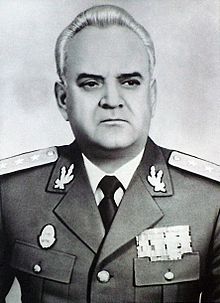Vasile Milea
Vasile Milea | |
|---|---|
 | |
| 75th Minister of National Defense of Romania | |
| In office 16 December 1985 – 22 December 1989 | |
| President | Nicolae Ceaușescu |
| Prime Minister | Constantin Dăscălescu |
| Preceded by | Constantin Olteanu |
| Succeeded by | Victor Stănculescu (acting) |
| 89th Chief of the Romanian General Staff | |
| In office 31 March 1980 – 16 February 1985 | |
| President | Nicolae Ceaușescu |
| Preceded by | Ion Hortopan |
| Succeeded by | Ștefan Gușă |
| Personal details | |
| Born | 1 January 1927 Lerești, Argeș County, Kingdom of Romania |
| Died | 22 December 1989 (aged 62) Bucharest, Socialist Republic of Romania |
| Profession | Military Officer |
| Military service | |
| Rank | Colonel general |
Vasile Milea (1 January 1927 - 22 December 1989) was a Romanian politician and general who was Nicolae Ceaușescu's Minister of Defence during the Romanian Revolution of 1989 and was involved in the reprisal phase of the Revolution that caused the deaths of 162 people.
Biography
[edit]Milea was appointed Minister of Defence, replacing Constantine Olteanu, in December 1984.[1]
Death
[edit]The cause of Milea's death is uncertain - he may have been murdered on Ceaușescu's orders, or killed himself.[2] Milea was already in severe disfavour for sending troops to quell the uprising in Timișoara without ammunition[3] and for his refusal to order the army to shoot the protestors who had gathered around the Central Committee building.[4]
His death is believed to have happened at about 10:40 a.m.[4] and was announced as a suicide on television early on 22 December which described him as a traitor and may have been interpreted by other generals as a sign of growing distrust leading to their loyalty wavering.[5] Whatever the case, Milea's death caused the rank-and-file soldiers to go over almost en masse to the revolution, effectively ending the Communist rule in Romania.[6] He was succeeded as Minister of Defence by Victor Stanculesc who also disobeyed orders and returned the army to barracks.[7]
A report in 1989 indicated that he had been shot by Ceausescu’s Securitate[5] although this was contradicted by a report from 2005 after a full investigation including a post-mortem concluded that Milea killed himself using the weapon of one of his attendants. It was suggested that he only tried to incapacitate himself in order to be relieved from office, but the bullet hit an artery and he died soon afterwards.[8]
Legacy
[edit]
A boulevard in Sector 6 of Bucharest used to be named after him until 2021. A street in Ploiești[9] is still named after him, as well as a central square in Pitești.
Works
[edit]- Vasile Milea, Victor Atanasiu, România în anii primului război mondial: caracterul drept, eliberator al participării României la război, vol. 2, Ed. Militară, Bucharest, 1987. OCLC 18616519
References
[edit]- ^ Crowther, William (1989). ""Ceausescuismn" and Civil-Military Relations in Romania". Armed Forces and Society. 15: 171–219.
- ^ "'Shameful but necessary': How despots who starved the people met their end". The Independent. 25 December 2019. p. 34.
- ^ Sebetsyen, Victor (2009). Revolution 1989: The Fall of the Soviet Empire. New York City: Pantheon Books. ISBN 978-0-375-42532-5., p. 389
- ^ a b Deletant, D (1994). "Review:Myth-Making and the Romanian Revolution [Review of The Wasted Generation: Memoirs of the Romanian Journey from Capitalism to Socialism and Back, by S. Brucan]". The Slavonic and East European Review. 72 (3): 483–491.
- ^ a b Hall, Richard Andrew (2000). "Theories of Collective Action and Revolution: Evidence from the Romanian Transition of December 1989". Europe-Asia Studies. 52 (6): 1069–1093. doi:10.1080/09668130050143833.
- ^ Jeremy Bransten (1999), "Romania: The Bloody Revolution in 1989: Chaos As The Ceausescus Are Executed", Ten Years After: The Fall of the Communism in East/Central Europe.
- ^ Granville, Johanna (2010). "Forewarned is Forearmed: How the Hungarian Crisis of 1956 Helped the Romanian Leadership". Europe-Asia Studies. 62 (4): 615–645. doi:10.1080/09668131003736979.
- ^ Flavius Cristian Marcau, "Revolution of 1989: Milea's Suicide", University of Târgu Jiu, Letter and Social Science Series, Issue 4, 2013, Retrieved 27 February 2016.
- ^ "Strada General Vasile Milea". orasul.biz (in Romanian). Retrieved 18 February 2022.
- 1927 births
- 1989 deaths
- Chiefs of the General Staff of Romania
- People from Argeș County
- People of the Romanian revolution
- Romanian Land Forces generals
- Ministers of defence of Romania
- Romanian Communist Party politicians
- Members of the Great National Assembly
- Deaths by firearm in Romania
- Romanian politician stubs
